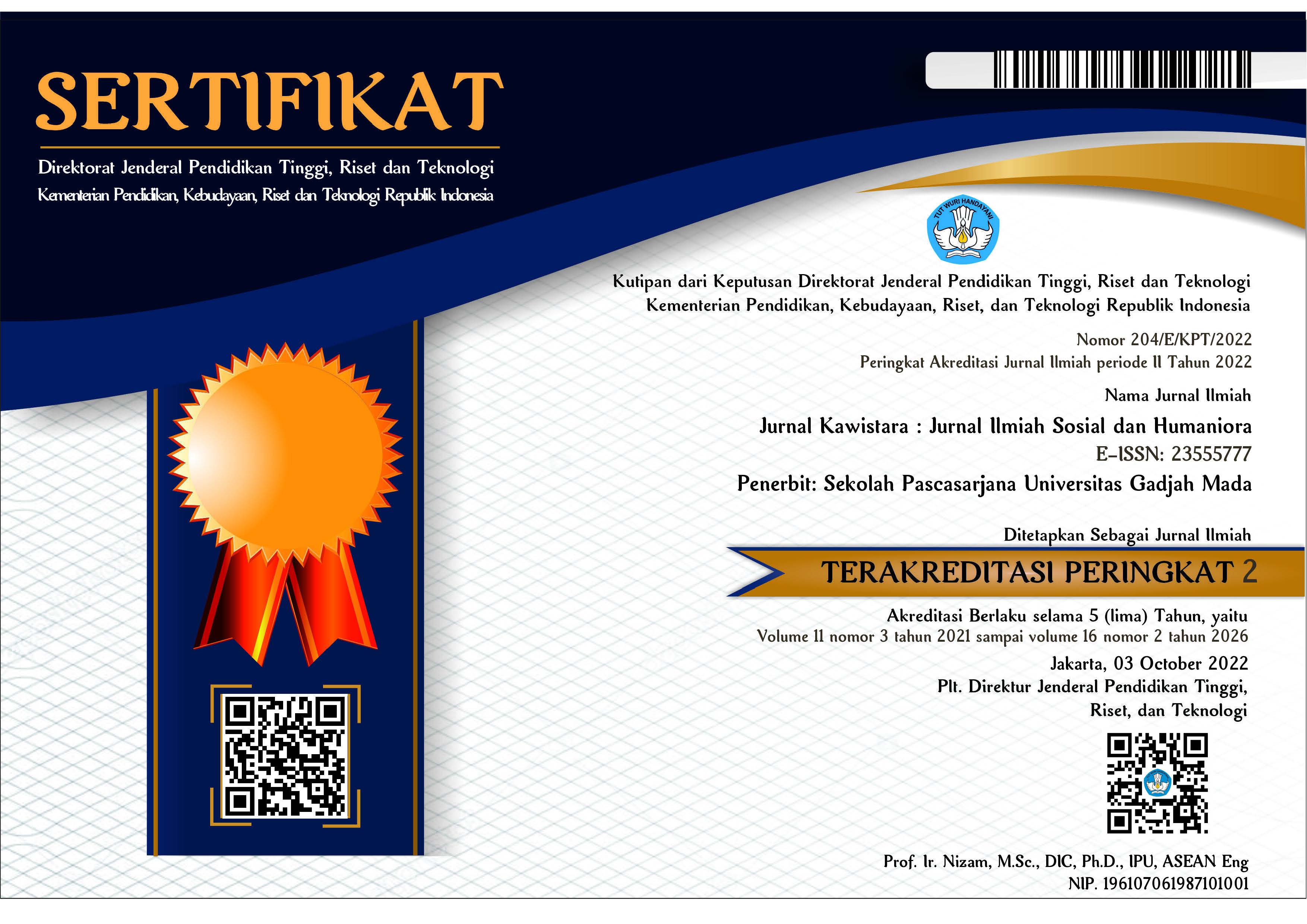Knowledge and Power in Indonesian Traditional Music: A Genealogical Approach on the Transformation of the Meaning of Karawitan
Ji Pyo Chung(1*)
(1) Universitas Gadjah Mada
(*) Corresponding Author
Abstract
The term Karawitan is generally known to mean gamelan music, more specifically Javanese, Balinese, and Sundanese gamelan music tuned to slendro and pelog scales. However, the term is discursive and has meaning in wider contexts as well. The term karawitan first appeared during the colonial period in royal courts on Java to indicate Javanese gamelan music. However, through its nation-wide university karawitan programs, the Indonesian government and art academics use the term to refer to all Indonesian traditional music practices (Musik Nusantara).Thisarticle gives a postcolonial account of the discourse surrounding the term karawitan to trace the transformation of its meaning. It employs Michel Foucault's theory of discourse and genealogical research methods to explore colonial-era and post-colonial literature using the term karawitan. By reviewing various discourses about karawitan, authors provide a more nuanced understanding about how power operates in the context of traditional music in Indonesia. We illustrate how the meaning of “karawitan” has been re-defined and contested through discursive practices. In general, these transformations demonstrate a shift from colonial power to national power
Keywords
Full Text:
PDFReferences
Aryasa, I. (1976/1977). Perkembangan Seni Karawitan Bali. Denpasar: Proyek Sasana Budaya Bali.
Bandem, I. M. (2013). Gamelan Bali di atas Panggung Sejarah. Denpasar: Stikom Bali.
Becker, J. (1980a). From Oral to Written Tradition in Javanese Music. In J. Becker (Ed.), Traditional Music in Modern Java: Gamelan in a Changing Society (pp. 11-25). Honolulu: University of Hawai’i Press.
Becker, J. (1980b). Western Influence in Gamelan Music. In J. Becker (Ed.), Traditional Music in Modern Java: Gamelan in a Changing Society (pp. 66-77). Honolulu: University of Hawai’i Press.
Becker, J. (1993). Gamelan Stories: Tantrism, Islam, and Aesthetics in Central Java. Arizona: Arizona State University.
Clowney, D. (2011). Definitions of Art and Fine Art’s Historical Origins. The Journal of Aesthetics and Art Criticism, 69(3), 309-320.
Daryanto, S. (1998). Pengantar Karawitan dan Kumpulan Gending. Surakarta: Pustaka Ammur.
Dibia, I. W. (2012). Geliat Seni Pertunjukan Bali. Denpasar: Arti Foundation.
Endraswara, S. (2008). Laras Manis Tuntunan Praktis Karawitan Jawa. Yogyakarta: Kultul.
Foucault, M. (1989). Archeology of knowledge. New York: Routledge.
Foucault, M. (1995). Discipline and Punish. New York: Vintage Books.
Foucault, M. (1980). Power/Knowledge. New York: Pantheon Books.
Hand, R. (2018). Schools and Families as Institutions of Learning in Central Javanese Gamelan. Ethnomusicology Forum, 27(1), 68-87.
Harnish, D. (2005). Teletubbies in Paradise: Tourism, Indonesianisation and Modernisation in Balinese Music. Yearbook for Traditional Music, 37, 103-123.
Hill, D. (2001). The Practice and Social Evolution of The Javanese Gamelan: evolution and continuity. Contemporary Theatre Review, 11(1), 19-27.
HS and Merta, D. (2018). Peta dan Arkeologi Gamelan Nusantara. Yogyakarta: Gading.
Kartomi, M. J. (1990). Music in Nineteenth Century Java: A Precursor to the Twentieth Century. Journal of Southeast Asian Studies, 21(1), 1-34.
Koesoemadinata, R. M. A. (1969). Ilmu Seni dan Raras. Djakarta: Pradnja Paramita.
Miller, L. E., & Lieberman, F. 1999. Lou Harrison and the American Gamelan. American Music, 17(2), 146-178.
Palgunadi, B. (2002). Serat Kandha Karawitan Jawi. Bandung: ITB.
Pickvance, R. (2005). A Gamelan Manual: a player’s guide to the central Javanese gamelan. United Kingdom: Jaman Mas Books.
Purbodiningrat, R. T. (1987). Gamelan, In J. Becker & A. H. Feinstein (Eds.), Karawitan: Source Reading in Javanese Gamelan and Vocal Music, Vol. 2 (pp. 235-259). Michigan: University of Michigan Press.
Rizzo, R. (2020). Knowledge Trasmission in Javanese Karawitan: Is It Time for an Ontological Turn?. Asian Music, 51(1), 94-117.
Saukko, P. (2003). Doing Research in Cultural Studies: An Introduction to Classical and New Methodological Approaches. London: SAGE Publication.
Sindoesawarno, K. (1984). Faktor Penting Dalam Karawitan, In J. Becker & A H. Feinstein (Eds.), Karawitan: Source Reading in Javanese Gamelan and Vocal Music. Vol. 1 (pp. 391-405). Michigan: University of Michigan Press.
Soetrisno, R. (1976). Sejarah Karawitan. Surakarta: Akademi Seni Karawitan Indonesia Surakarta.
Spiller, H. (2008). Focus: Gamelan Music of Indonesia. New York: Routledge.
Sukerta, P. M. (2009). Gong Kebyar Buleleng: Perubahan dan Keberlanjutan Tradisi Gong Kebyar. Surakarta: ISI Press Surakarta.
Sumarsam. (1991). Sejarah Perkembangan Teori Gamelan oleh Penulis-penulis Indonesia. In I. M. Bandem (Ed.), Seni Pertunjukan Indonesia (pp. 11-35), Surakarta: Yayasan Masyaratkat Musikologi Indonesia.
Sumarsam. (1995). Gamelan: Cultural Interaction and Musical Development in Central Java. Chicago: University of Chicago Press.
Supanggah, R. (1995). Education in Traditional Indonesian Music. International Forum on Asian Traditional Music and Dance, Thailand. Chulalongkorn University: 61-69.
Supanggah, R. (2002). Bothekan Karawitan 1. Jakarta: Masyarakat Seni Pertunjukan Indonesia.
Sutton, R. A. (1991). Traditions of Gamelan Music in Java: musical pluralism and regional identity. Cambridge: Cambridge University.
Taruskin, R. (2015). The Oxford history of Western music. Oxford: Oxford University Press.
Tenzer, M. (2011). Balinese Gamelan Music. Singapore: Tuttle Publishing.
Interview
Rusdiyantoro, Surakarta, 17th, June, 2021.
Article Metrics
Refbacks
- There are currently no refbacks.
Copyright (c) 2023 Ji Pyo Chung

This work is licensed under a Creative Commons Attribution-ShareAlike 4.0 International License.
Jurnal Kawistara is published by the Graduate School, Universitas Gadjah Mada.







